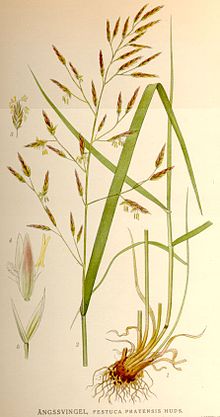- Festuca pratensis
-
Festuca pratensis 
Scientific classification Kingdom: Plantae (unranked): Angiosperms (unranked): Monocots (unranked): Commelinids Order: Poales Family: Poaceae Genus: Festuca Species: F. pratensis Binomial name Festuca pratensis
Huds.Festuca pratensis, the Meadow fescue[1], ( syn. Bromus pratensis (Huds.) Spreng., Bucetum pratense (Huds.) Parn., Festuca fluitans L. var. pratensis (Huds.) Huds., Festuca elatior L. subsp. pratensis (Huds.) Hack., Lolium pratense (Huds.) Darbysh., Tragus pratensis (Huds.) Panz. ex B.D.Jacks., and Schedonorus pratensis (Huds.) P.Beauv.) is a perennial species of grass, which is often used an ornamental grass in gardens.
It is an important forage crop.
It grows in meadows, on roadsides, old pastures riversides etc. on moist, rich soils, especially on loamy and heavy soils.
It is a tall, tufted grass similar to tall fescue Festuca arundinacea. Tall fescue differs by having minute hairs on the auricles
Description
It is a perennial bunchgrass, (ie grows in tufts), which grows between 30 and 120 cm (47 in), flowering from June until August. The panicles are green to purplish. The spikelets have 5 to 14 flowers.
It has a short blunt ligule compared to other grasses 1mm high. The leaves are bright green.
Photos
References
- Pink, A. (2004). Gardening for the Million. Project Gutenberg Literary Archive Foundation. http://www.gutenberg.org/etext/11892.
This Pooideae article is a stub. You can help Wikipedia by expanding it.




